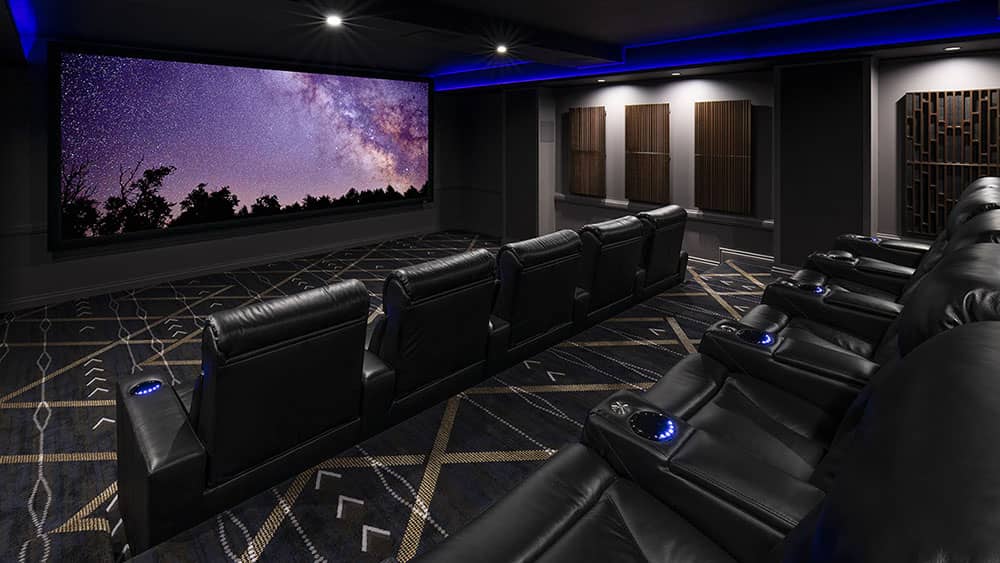Creating a home theater is the ultimate way to elevate your entertainment experience. Whether you’re a movie buff, sports enthusiast, or gaming fanatic, having a personalized theater space can transform how you enjoy your favorite content. In this guide, we’ll walk you through everything you need to know on how to create a home theater, from choosing the right equipment to designing a comfortable, immersive space.
1. Planning Your Home Theater Space
Before diving into equipment and décor, the first step is to plan your home theater’s location. The room you choose plays a crucial role in determining the quality of your setup.
- Room Selection: Ideally, you’ll want a room with minimal windows to avoid unwanted glare and light leakage. A basement, spare bedroom, or a dedicated media room are great options.
- Size and Layout: The size of your room will influence your screen size and seating arrangement. Make sure there’s enough distance between where you sit and where your display will be.
- Acoustics: Consider the room’s natural acoustics. Rooms with carpeted floors, fewer windows, and solid walls tend to offer better sound quality.
2. Selecting the Right Equipment
The equipment you choose is the heart of your home theater. The goal is to create a high-quality audio and visual experience. Here’s what you’ll need:
- Display Options: TV vs. Projector
- TVs are generally easier to set up, offer excellent brightness, and are perfect for smaller rooms. Look for a 4K Ultra HD TV with HDR for the best picture quality.
- Projectors offer a more cinematic experience, especially for larger rooms. They require a screen or flat surface for projection and can deliver an image size of 100 inches or more.
- Audio System: Surround Sound vs. Soundbar
- Surround Sound Systems: For the full theater experience, a 5.1 or 7.1 surround sound system is ideal. These systems include multiple speakers strategically placed around the room for immersive sound.
- Soundbars: If you’re working with limited space or budget, a soundbar is a simpler option. Many modern soundbars offer excellent sound quality and even virtual surround sound.
- Source Components
- Streaming Devices: A reliable streaming device (like Roku, Apple TV, or Chromecast) will allow you to access services like Netflix, Disney+, and Hulu.
- Blu-ray Players and Consoles: For those who enjoy physical media or gaming, Blu-ray players and gaming consoles can double as your primary content source.
3. Lighting and Seating for Comfort
Comfort is key to enjoying your home theater, and lighting and seating play a huge role in achieving the right atmosphere.
- Optimal Lighting: Avoid harsh, direct lighting. Use dimmable lights, LED strips, or wall sconces to create a soft ambiance that enhances viewing without causing glare on the screen.
- Seating Arrangements: For maximum comfort, opt for recliners or couches designed for home theaters. If you have the space, consider tiered seating for an authentic theater experience.
- Cozy Atmosphere: Consider adding throw blankets, cushions, or even a small side table for snacks and drinks to make the space more inviting.
4. Soundproofing and Acoustics
Soundproofing your home theater can make a significant difference, especially if you want to prevent disturbing others in your household or neighbors.
- Soundproofing: Use acoustic panels, heavy curtains, or specialized soundproofing materials for walls, doors, and floors to keep sound contained within the room.
- Acoustic Treatments: To improve sound quality, consider adding bass traps or diffusers to manage sound reflections and minimize echo, ensuring crystal-clear audio.
5. Wiring and Connectivity
A clutter-free home theater requires careful consideration of wiring and connectivity.
- Cable Management: Plan the wiring for your speakers, projector, and other devices early on. Use cable organizers and hide wires behind walls or under carpets for a clean look.
- Smart Controls: Consider integrating a smart home system for easy control of your lighting, audio, and video equipment. Systems like Alexa, Google Home, or a universal remote make it easier to adjust settings with just your voice or a single touch.
6. Final Touches for the Perfect Experience
Once you’ve set up the basics, it’s time to add personal touches that make your home theater uniquely yours.
- Decor and Themes: Choose a décor theme that complements the overall vibe you want to create. Whether it’s a retro movie theme, a modern minimalist style, or a pop-culture-inspired look, your décor can set the tone for the space.
- Snack Station: No theater experience is complete without snacks! Set up a small concession area with popcorn, candy, and drinks to make your movie nights feel authentic.
- Storage Solutions: Install shelves or cabinets to keep your DVDs, Blu-rays, and gaming accessories neatly organized.
Conclusion
Building a home theater doesn’t have to be complicated or expensive. With the right planning, equipment, and personal touches, you can create an entertainment space that rivals any commercial cinema. Now that you know how to create a home theater, it’s time to start planning your dream setup and enjoy the ultimate entertainment experience in the comfort of your own home.
For more lifestyle tips and inspiration, visit lifestylerule.com.




